人教版高中英语选修八课件: Unit 5 Meeting-your-ancestors-Reading(共21张PPT)
文档属性
| 名称 | 人教版高中英语选修八课件: Unit 5 Meeting-your-ancestors-Reading(共21张PPT) | 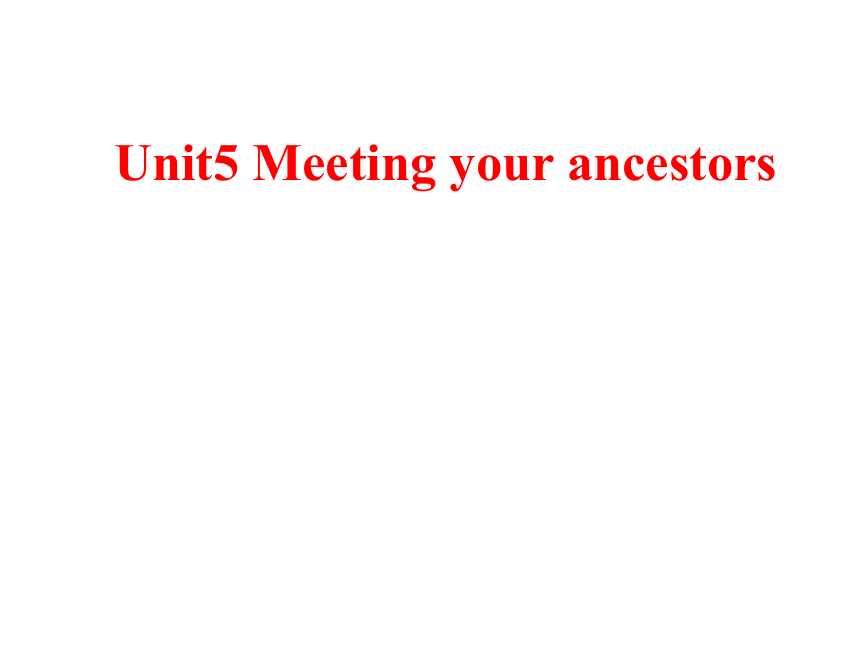 | |
| 格式 | zip | ||
| 文件大小 | 787.0KB | ||
| 资源类型 | 教案 | ||
| 版本资源 | 人教版(新课程标准) | ||
| 科目 | 英语 | ||
| 更新时间 | 2020-04-23 11:49:14 | ||
图片预览



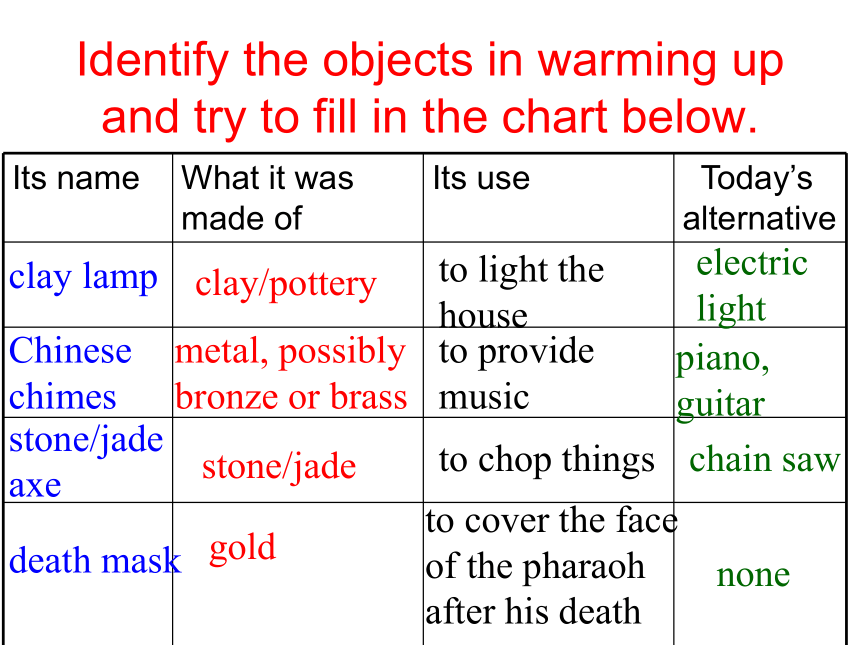
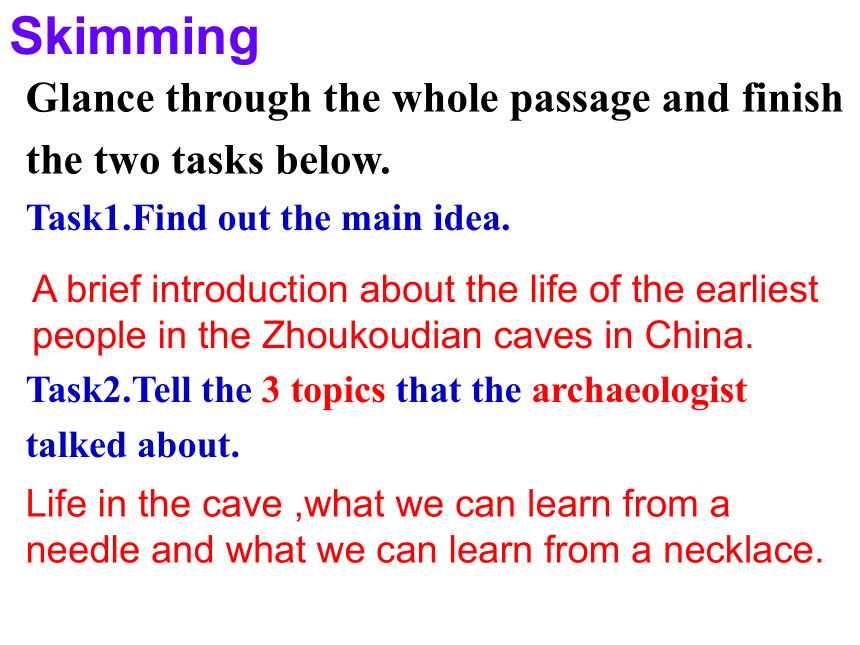

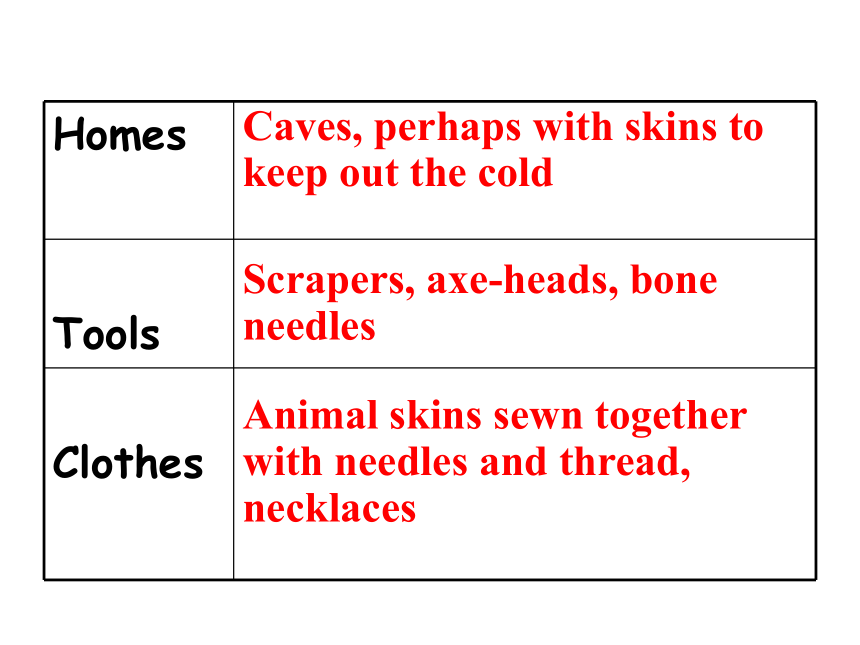

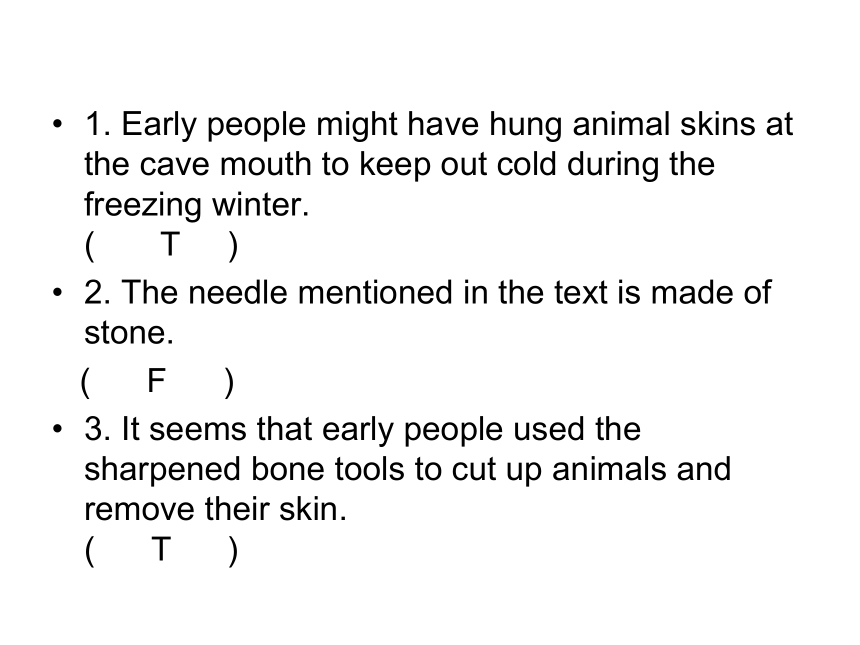
文档简介
课件21张PPT。Unit5 Meeting your ancestorsA household object from GreeceA musical instrumentA stone toolA face of an Egyptian Pharaoh
[?fe?r??]
法老Identify the objects in warming up and try to fill in the chart below.clay lampclay/potteryelectric lightto light the houseChinese
chimesmetal, possibly bronze or brassto provide musicpiano, guitarstone/jade axestone/jadeto chop thingschain sawdeath maskgoldto cover the face of the pharaoh after his deathnoneGlance through the whole passage and finish the two tasks below.
Task1.Find out the main idea.
Task2.Tell the 3 topics that the archaeologist talked about.
SkimmingA brief introduction about the life of the earliest people in the Zhoukoudian caves in China.Life in the cave ,what we can learn from a needle and what we can learn from a necklace.
Read the text again and write down the three ways in which the life of early people differs from your own, using the information in the reading to help you.ScanningCaves, perhaps with skins to keep out the coldScrapers, axe-heads, bone needlesAnimal skins sewn together with needles and thread, necklacesCareful reading一. Here are 5 statements. Decide whether they are right or wrong according to your comprehension of the texts you have learned and write T for True or F for False respectively:
1. Early people might have hung animal skins at the cave mouth to keep out cold during the freezing winter. ( T )
2. The needle mentioned in the text is made of stone.
( F )
3. It seems that early people used the sharpened bone tools to cut up animals and remove their skin. ( T )
4. Early people cared about their appearance like we do. ( T )
5. Early people grew their own crops, picked fruit and hunted animals. ( F )
二. Choose the best answer.1. Where do the Zhoukoudian caves lie?
A. In the forest.
B. On the seaside.
C. At the foot of the hill.
D. Higher up the hill.2. Which of the following is the correct order about how early people made clothes?
a. clean the fat and meat from the skin
b. cut up the animals
c. rub salt inside the skin
d. remove the skin
e. sew the pieces together
A. b-d-c-a-e B. b-d-a-c-e
C. b-a-d-c-e D. b-a-c-d-e3. Which of the following shows us the earliest people and the modern people have something in common?
A. People hung animal skins to keep out the cold
B. People never grew their own crops
C. People use science
D. People care about their appearance4. What can we infer from the sentences--- “This one looks very like a fish bone. Is it reasonable? ---Yes indeed, as the botanical analyses have shown us, all the fields around here used to be part of a large shallow lake. Probably there were fish in it.”?
A. Being an archaeologist needs a wide range of knowledge.
B. A lake is not the sea.
C. People can identify the fish by the colour.
D. A fish bone can be made into a necklace.Stone, wooden or brick house. CaveCompare modern people and Peking man, and finish the following form.Post-reading part I Wooden, special for each roomfireplace TV, sport, films, hobbies, education, job Meals together Fruit, vegetables, meat and fish, etc. Meat, fish, berries and fruit in season Natural and man-made fibres. skins, leaves Post Reading Part II: A summary of the text
A group of students from _____ came to the Zhoukoudian caves for a _____. An archaeologist showed them _____. He explained it was in the Zhoukoudian caves that they found _____ of some of the earliest people. The students _____ how the earliest people could live there. The archaeologist thought it was _____ because they found human and animal ____ in the caves as well as _____ and other objects, such as ____ and a _____.
Assignment:
Read the passage again and try to list all the sentences with Present perfect continuous forms (现在完成进行时).
[?fe?r??]
法老Identify the objects in warming up and try to fill in the chart below.clay lampclay/potteryelectric lightto light the houseChinese
chimesmetal, possibly bronze or brassto provide musicpiano, guitarstone/jade axestone/jadeto chop thingschain sawdeath maskgoldto cover the face of the pharaoh after his deathnoneGlance through the whole passage and finish the two tasks below.
Task1.Find out the main idea.
Task2.Tell the 3 topics that the archaeologist talked about.
SkimmingA brief introduction about the life of the earliest people in the Zhoukoudian caves in China.Life in the cave ,what we can learn from a needle and what we can learn from a necklace.
Read the text again and write down the three ways in which the life of early people differs from your own, using the information in the reading to help you.ScanningCaves, perhaps with skins to keep out the coldScrapers, axe-heads, bone needlesAnimal skins sewn together with needles and thread, necklacesCareful reading一. Here are 5 statements. Decide whether they are right or wrong according to your comprehension of the texts you have learned and write T for True or F for False respectively:
1. Early people might have hung animal skins at the cave mouth to keep out cold during the freezing winter. ( T )
2. The needle mentioned in the text is made of stone.
( F )
3. It seems that early people used the sharpened bone tools to cut up animals and remove their skin. ( T )
4. Early people cared about their appearance like we do. ( T )
5. Early people grew their own crops, picked fruit and hunted animals. ( F )
二. Choose the best answer.1. Where do the Zhoukoudian caves lie?
A. In the forest.
B. On the seaside.
C. At the foot of the hill.
D. Higher up the hill.2. Which of the following is the correct order about how early people made clothes?
a. clean the fat and meat from the skin
b. cut up the animals
c. rub salt inside the skin
d. remove the skin
e. sew the pieces together
A. b-d-c-a-e B. b-d-a-c-e
C. b-a-d-c-e D. b-a-c-d-e3. Which of the following shows us the earliest people and the modern people have something in common?
A. People hung animal skins to keep out the cold
B. People never grew their own crops
C. People use science
D. People care about their appearance4. What can we infer from the sentences--- “This one looks very like a fish bone. Is it reasonable? ---Yes indeed, as the botanical analyses have shown us, all the fields around here used to be part of a large shallow lake. Probably there were fish in it.”?
A. Being an archaeologist needs a wide range of knowledge.
B. A lake is not the sea.
C. People can identify the fish by the colour.
D. A fish bone can be made into a necklace.Stone, wooden or brick house. CaveCompare modern people and Peking man, and finish the following form.Post-reading part I Wooden, special for each roomfireplace TV, sport, films, hobbies, education, job Meals together Fruit, vegetables, meat and fish, etc. Meat, fish, berries and fruit in season Natural and man-made fibres. skins, leaves Post Reading Part II: A summary of the text
A group of students from _____ came to the Zhoukoudian caves for a _____. An archaeologist showed them _____. He explained it was in the Zhoukoudian caves that they found _____ of some of the earliest people. The students _____ how the earliest people could live there. The archaeologist thought it was _____ because they found human and animal ____ in the caves as well as _____ and other objects, such as ____ and a _____.
Assignment:
Read the passage again and try to list all the sentences with Present perfect continuous forms (现在完成进行时).
